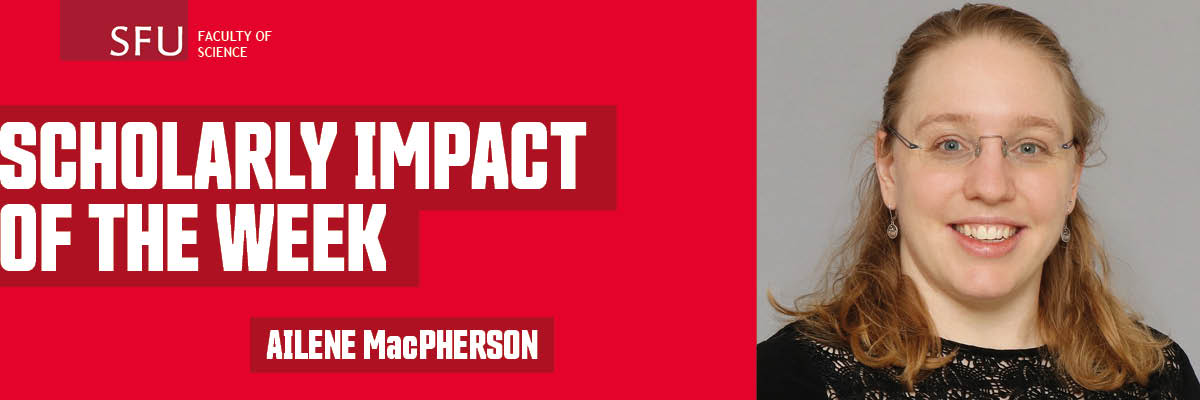
Whether studying ancient DNA, or following the trajectory of an emerging pathogen, tracking the evolution of biological diversity helps scientists understand why different species thrive and others go extinct. It also contributes to the knowledge of relationships between different species. Most recently, studying the genomic sequences of the COVID-19 virus is helping scientists monitor its spread.
Mapping the epidemiology and evolution of a pathogen like COVID-19 and its evolutionary history takes the unique skills of a mathematician. Simon Fraser University (SFU) Mathematics Professor Ailene MacPherson uses mathematical and statistical tools to address questions at the intersection of evolution, ecology and epidemiology. With advanced degrees in both zoology and mathematics, she has expertise in both biological diversity and applied mathematics. She was named a recipient of the 2022 James F. Crow Early Career Researcher Award recognizing her exceptional work as a recent doctoral graduate in the field of genetics.
One of MacPherson’s research focuses is investigating how both host and pathogen genetics shape disease spread and severity. In addition to studying emergent pathogens, she also investigates the long-term associations between hosts and pathogens, to better understand how these complex co-evolutionary interactions shape the biological diversity of the world.
In her recent paper, Unifying Phylogenetic Birth-Death Models in Epidemiology and Macroevolution, MacPherson worked with researchers from the University of Oregon and the University of British Columbia. The paper discusses several mathematical models used to track the evolution of species, and notes that all biological diversity can be described with the same mathematical models. She proposes unifying these models into a single framework that can serve as a guide for scientists and mathematicians.
We talked with Professor MacPherson about her research.
Can you walk us through the novel approach you are exploring in your paper?
The novelty of this paper is the generality of the method. Biological diversification has been studied extensively in both the macroevolutionary context with regards to speciation and extinction, and in the epidemiological context, for example, disease transmission and host recovery. What we do here is bring models used for studying that diversification under a single umbrella. The resulting method allows us to understand everything from mass extinctions and the collection of fossils to public health policies that change when and how people are tested for an emergent infectious disease. A key aim of this work was to provide a resource for scientists from diverse backgrounds to understand the methods that they use, the range of possibilities for future data analysis, and to provide a mathematical basis for testing the limitations of these approaches.
Is it possible to use historical data for long-known pathogen to help determine how a new pathogen might evolve?
Yes and no. One of the best studied examples of pathogen evolution is influenza where researchers have developed sophisticated and accurate methods for predicting the characteristics of future outbreaks for effective vaccine design—but every pathogen is different with each having unique properties, for example, evolutionary rates, making it difficult to generalize. Nevertheless, a foundational element of evolutionary epidemiology is to embrace this biological diversity and learn both general properties of pathogen evolution and the specifics for individual diseases. Our knowledge in this area is growing rapidly—and it is likely to be an exciting scientific frontier for many years to come.
Are we getting better at predicting the trajectory of a pathogen, or is the natural world just too unpredictable?
One of my favourite areas of mathematics is the field of stochastic processes. What this means is the study of randomness. While change in the natural world is inherently random, as a theoretical biologist I can use tools from stochastic processes to learn the underlying principles through the noise of nature. So yes, we already know a lot about how pathogens can evolve, but it is a huge undertaking. Luckily, the tools we have to study pathogen evolution are also growing. Building the mathematical tools to help us is central to my research.
Genomic epidemiology and genomic sequencing is at a pivotal moment and has emerged as a key to understand the COVID-19 pandemic. Can you describe what is happening in this area?
Analysis of pathogen genome sequences can provide valuable insights into the spread of infectious diseases. Genomic approaches enable us to track infection incidence, follow the intra and international spread of an epidemic, and can identify case clusters that warrant public health intervention. The emergence and spread of COVID-19 variants—and the impact variants have on the control of the pandemic—highlights the growing importance of viewing epidemiology in the light of evolution.
Your online biography states that you really love math. What is it about math that you most appreciate?
Math is a window into the natural world. When I am working on math, I am constantly visualizing what the equations mean. This allows me to not only see the beauty of nature out my window, but to see across generations and over millions of years of natural history. It’s the best movie in the world.
This work was supported by the public health and safety organization, NSF, the Natural Sciences and Engineering Research Council of Canada, the University of Toronto, Genome Canada, the Canadian Institutes of Health Research and the British Columbia Centre for Excellence in HIV/AIDS.
For more: Check out the Mathematics Genomics and Prediction in Infection and Evolution (MAGPIE) Group at SFU
SFU's Scholarly Impact of the Week series does not reflect the opinions or viewpoints of the university, but those of the scholars. The timing of articles in the series is chosen weeks or months in advance, based on a published set of criteria. Any correspondence with university or world events at the time of publication is purely coincidental.
For more information, please see SFU's Code of Faculty Ethics and Responsibilities and the statement on academic freedom.